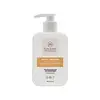What's inside
What's inside
 Key Ingredients
Key Ingredients

 Benefits
Benefits

 Concerns
Concerns

 Ingredients Side-by-side
Ingredients Side-by-side

Water
Skin ConditioningCocamidopropyl Betaine
CleansingAloe Barbadensis Leaf Juice
Skin ConditioningSodium Methyl 2-Sulfolaurate
CleansingGlycerin
HumectantSodium Sulfate
Disodium 2-Sulfolaurate
CleansingGlyceryl Caprylate/Caprate
EmollientPotassium Sorbate
PreservativeSodium Benzoate
MaskingCitric Acid
BufferingEthylhexylglycerin
Skin ConditioningCymbopogon Schoenanthus Oil
MaskingMonarda Didyma Oil
TonicPelargonium Graveolens Flower Oil
MaskingRosa Damascena Flower Extract
MaskingRosa Damascena Flower Water
MaskingC12-15 Alkyl Benzoate
AntimicrobialSalicylic Acid
MaskingSodium Polyacrylate
AbsorbentTanacetum Annuum Flower/Leaf/Stem Oil
MaskingCeramide NP
Skin ConditioningRosa Damascena Flower Wax
MaskingSynthetic Beeswax
Emulsion StabilisingTocopheryl Acetate
AntioxidantHydrogenated Lecithin
EmulsifyingPolyglyceryl-10 Stearate
Skin ConditioningSucrose Stearate
EmollientPhenoxyethanol
PreservativeSodium Hyaluronate
HumectantUbiquinone
AntioxidantHibiscus Sabdariffa Flower Extract
Skin ConditioningPalmitoyl Tripeptide-5
Skin ConditioningWater, Cocamidopropyl Betaine, Aloe Barbadensis Leaf Juice, Sodium Methyl 2-Sulfolaurate, Glycerin, Sodium Sulfate, Disodium 2-Sulfolaurate, Glyceryl Caprylate/Caprate, Potassium Sorbate, Sodium Benzoate, Citric Acid, Ethylhexylglycerin, Cymbopogon Schoenanthus Oil, Monarda Didyma Oil, Pelargonium Graveolens Flower Oil, Rosa Damascena Flower Extract, Rosa Damascena Flower Water, C12-15 Alkyl Benzoate, Salicylic Acid, Sodium Polyacrylate, Tanacetum Annuum Flower/Leaf/Stem Oil, Ceramide NP, Rosa Damascena Flower Wax, Synthetic Beeswax, Tocopheryl Acetate, Hydrogenated Lecithin, Polyglyceryl-10 Stearate, Sucrose Stearate, Phenoxyethanol, Sodium Hyaluronate, Ubiquinone, Hibiscus Sabdariffa Flower Extract, Palmitoyl Tripeptide-5
Water
Skin ConditioningAloe Barbadensis Leaf Juice
Skin ConditioningDecyl Glucoside
CleansingCocamidopropyl Betaine
CleansingCocamidopropyl Hydroxysultaine
CleansingDimethyl Sulfone
SolventSodium Ascorbyl Phosphate
AntioxidantCocamide Mipa
EmulsifyingPhenoxyethanol
PreservativeDisodium Laureth Sulfosuccinate
CleansingDisodium Lauryl Sulfosuccinate
CleansingAcrylates/C10-30 Alkyl Acrylate Crosspolymer
Emulsion StabilisingSodium Hydroxide
BufferingEthylhexylglycerin
Skin ConditioningOlea Europaea Fruit Oil
MaskingCentella Asiatica Extract
CleansingEquisetum Arvense Extract
AstringentGeranium Maculatum Extract
TonicTaraxacum Officinale Extract
Skin ConditioningBorago Officinalis Seed Oil
EmollientRosa Canina Fruit Oil
EmollientCitrus Aurantium Dulcis Peel Extract
Emulsion StabilisingOriganum Vulgare Extract
Skin ConditioningWater, Aloe Barbadensis Leaf Juice, Decyl Glucoside, Cocamidopropyl Betaine, Cocamidopropyl Hydroxysultaine, Dimethyl Sulfone, Sodium Ascorbyl Phosphate, Cocamide Mipa, Phenoxyethanol, Disodium Laureth Sulfosuccinate, Disodium Lauryl Sulfosuccinate, Acrylates/C10-30 Alkyl Acrylate Crosspolymer, Sodium Hydroxide, Ethylhexylglycerin, Olea Europaea Fruit Oil, Centella Asiatica Extract, Equisetum Arvense Extract, Geranium Maculatum Extract, Taraxacum Officinale Extract, Borago Officinalis Seed Oil, Rosa Canina Fruit Oil, Citrus Aurantium Dulcis Peel Extract, Origanum Vulgare Extract
Ingredients Explained
These ingredients are found in both products.
Ingredients higher up in an ingredient list are typically present in a larger amount.
Aloe Barbadensis Leaf Juice comes from leaves of the aloe plant. Aloe Barbadensis Leaf Juice is best known for helping to soothe sunburns. It is also anti-inflammatory, moisturizing, antiseptic, and can help heal wounds.
Aloe is packed with good stuff including Vitamins A, C, and E. These vitamins are antioxidants, which help fight free-radicals and the damage they may cause. Free-radicals are molecules that may damage your skin cells, such as pollution.
Aloe Barbadensis Leaf Juice also contains sugars. These sugars come in the form of monosaccharides and polysaccharides, folic acid, and choline. These sugars are able to help bind moisture to skin.
It also contains minerals such as calcium, 12 anthraquinones, fatty acids, amino acids, and Vitamin B12.
Learn more about Aloe Barbadensis Leaf JuiceCocamidopropyl Betaine is a fatty acid created by mixing similar compounds in coconut oil and dimethylaminopropylamine, a compound with two amino groups.
This ingredient is a surfactant and cleanser. It helps gather the dirt, pollutants, and other impurities in your skin to be washed away. It also helps thicken a product and make the texture more creamy.
Being created from coconut oil means Cocamidopropyl Betaine is hydrating for the skin.
While Cocamidopropyl Betaine was believed to be an allergen, a study from 2012 disproved this. It found two compounds in unpure Cocamidopropyl Betaine to be the irritants: aminoamide and 3-dimethylaminopropylamine. High-grade and pure Cocamidopropyl Betaine did not induce allergic reactions during this study.
Learn more about Cocamidopropyl BetaineEthylhexylglycerin (we can't pronounce this either) is commonly used as a preservative and skin softener. It is derived from glyceryl.
You might see Ethylhexylglycerin often paired with other preservatives such as phenoxyethanol. Ethylhexylglycerin has been found to increase the effectiveness of these other preservatives.
Phenoxyethanol is a preservative that has germicide, antimicrobial, and aromatic properties. Studies show that phenoxyethanol can prevent microbial growth. By itself, it has a scent that is similar to that of a rose.
It's often used in formulations along with Caprylyl Glycol to preserve the shelf life of products.
Water. It's the most common cosmetic ingredient of all. You'll usually see it at the top of ingredient lists, meaning that it makes up the largest part of the product.
So why is it so popular? Water most often acts as a solvent - this means that it helps dissolve other ingredients into the formulation.
You'll also recognize water as that liquid we all need to stay alive. If you see this, drink a glass of water. Stay hydrated!
Learn more about Water